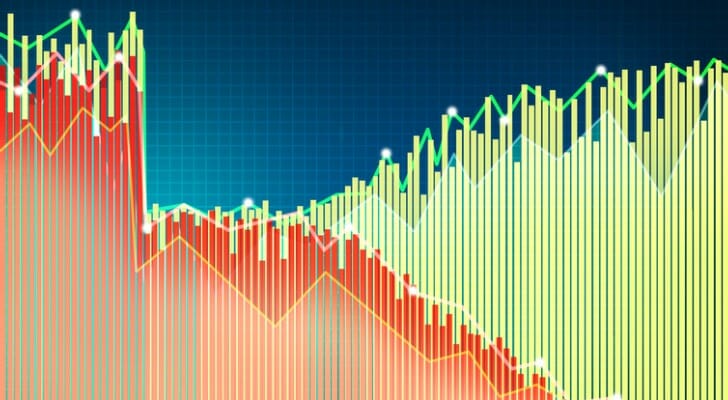 Sector rotation involves moving investments from one stock sector to another to keep pace with a changing economy. As the economy moves through different cycles, some stock sectors may perform better than others. Rotating investments allows investors to manage risk while potentially boosting returns, based on where the economy is at any given time. This strategy can be used by institutional and individual investors alike. Be sure to avail yourself of a financial advisor who can provide a more in-depth look at characteristics of various market sectors.
Sector rotation involves moving investments from one stock sector to another to keep pace with a changing economy. As the economy moves through different cycles, some stock sectors may perform better than others. Rotating investments allows investors to manage risk while potentially boosting returns, based on where the economy is at any given time. This strategy can be used by institutional and individual investors alike. Be sure to avail yourself of a financial advisor who can provide a more in-depth look at characteristics of various market sectors.
What Is Sector Rotation?
If the stock market was a pie, then stock sectors would represent the individual slices. There are 11 stock sectors to be exact, which are categorized along these lines:
- Information technology
- Financials
- Health care
- Consumer discretionary
- Consumer staples
- Communication services
- Industrials
- Energy
- Utilities
- Materials
- Real estate
Some sectors are larger than others, based on the number of companies they hold and the market capitalization of those companies. Each sector can perform differently, depending on what’s happening with the economy at any given time. Sector rotation offers investors an opportunity to capitalize on differences between the various sectors.
Stages of the Economic Cycle
The economic cycle or business cycle is characterized by four different phases. Understanding these phases is important for implementing a sector rotation strategy. Here’s how they compare:
- Early cycle phase. When an economy is in the early-cycle phase, the economy may be shifting from a period of contraction to one of expansion. For instance, the economy generally moves into early-cycle mode as the worst effects of a recession begin to wear off. The federal government may attempt to spur growth by moderating interest rates to encourage borrowing.
- Midcycle phase. At this stage, the economy may be growing at a faster pace. Companies may begin to see profit margins increase and lending activity may also be on the rise.
- Late cycle phase. During the later stages of the economic cycle, economic growth is approaching a tipping point. Companies may see sales begin to slow down while the Federal Reserve may raise interest rates to curb borrowing.
- Recession. In a recession, the economy contracts and shrinks. Consumers spend less, credit is harder to come by and companies may see sales decline substantially. The cycle begins all over again as the recession phase leads into the early-cycle phase.
The stock market can move in cycles as well. So, for example, during a recession, you might see the market hit bottom with stock prices dipping dramatically. But as the economy moves through the early to mid-cycle phases, stock prices recovering. Eventually, the market can hit a peak where stock prices don’t move higher or prices decline, turning the market from bullish to bearish. Stocks then can go back to a bottom, restarting the cycle again.
How Sector Rotation Works

The main principle behind sector rotating is making investments that align with changing economic cycles. This means knowing which sectors tend to fare better or worse, depending on where the economy is in the cycle. Certain sectors are defensive or noncyclical, meaning they can typically hold their own when the economic tide is turning negative. The top defensive sectors include:
- Utilities
- Consumer staples
- Healthcare
So why these three sectors, in particular? Simply, because even in a recession people are still going to spend money on utilities, health care and basic necessities like food. When the economy is starting to slow down or is in the early stages of a recession, these sectors can get a boost.
Other sectors are cyclical, meaning they can move up or down with the economic cycle. While defensive or non-cyclical stocks can perform well when the economy is slowing down, cyclical stocks tend to do better when the economy is strong.
Examples of cyclical sectors include:
- Consumer discretionary
- Real estate
- Information technology
Stocks in these sectors may not perform as well later in the economic cycle or in a recession, as consumers may spend less in these areas.
Implementing a sector rotation strategy means shifting your investments from one sector to another to try and get ahead of the business cycle or at least keep pace with it. So, for example, if the cycle is in the late stage and a recession is looming on the horizon, you might move more of your investments away from consumer discretionary stocks and into consumer staples instead.
Pros and Cons of Sector Rotation
The primary advantage of using a sector rotation strategy is that if done correctly, it could help investors to minimize losses as the economy moves from one end of the cycle spectrum to another. If you’re worried about how a recession might impact your portfolio, for example, trading out certain sectors for others in your asset allocation could make sense.
There are, however, some downsides to using sector rotation. For one thing, the economic cycle can change unpredictably, which may not give you enough time to make the necessary adjustments before a loss occurs. In early 2020, for instance, the economy was very quickly plunged into a recession due to the spread of the coronavirus pandemic. But the recovery phase happened almost as quickly.
Sector rotation may also be a mismatch for investors who prefer a more hands-off approach since it requires you to actively manage your portfolio to a degree. Investing in sector mutual funds or exchange-traded funds (ETFs) can save you the trouble of having to buy and sell individual stocks from different sectors. But you may still need to trade funds periodically as the cycle shifts.
If you’re a buy-and-hold investor, you may prefer to stick to your asset allocation and ride out the ups and downs. The upside to this approach is that you may benefit from dollar-cost averaging. With dollar-cost averaging, you continue buying into the market when prices are high and low. Over time, the difference in pricing averages out and because you remain invested, you can still generate a solid return overall.
The Bottom Line
 Sector rotation strategies are designed to make riding out ups and downs in the market easier for investors. The more you understand how the economic cycle works—and how the market reacts as a result—the easier it becomes to implement a rotation strategy to take advantage of the best-performing sectors at the right time. Keep in mind, however, that sector rotation alone can’t eliminate risk altogether so it’s important to consider your portfolio as a whole when making investment decisions.
Sector rotation strategies are designed to make riding out ups and downs in the market easier for investors. The more you understand how the economic cycle works—and how the market reacts as a result—the easier it becomes to implement a rotation strategy to take advantage of the best-performing sectors at the right time. Keep in mind, however, that sector rotation alone can’t eliminate risk altogether so it’s important to consider your portfolio as a whole when making investment decisions.
Tips for Investing
- Consider talking to your financial advisor about sector rotation and how to put it to work in your portfolio to help with managing risk. If you don’t have a financial advisor yet, finding one might be easier than you think. SmartAsset’s financial advisor matching tool helps you to connect with professional advisors in your local area. It takes just a few minutes to get personalized advisor recommendations online. If you’re ready, get started now.
- One of the best tools to use as you plan how to respond to a sector rotation is an asset allocation calculator.
Photo credit: ©iStock.com/LeoWolfert, ©iStock.com/iQoncept, ©iStock.com/wildpixel